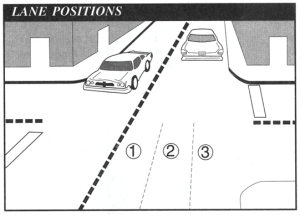
What is the best motorcycle lane position? The short answer is that it depends on the situation. It’s a choice that requires quick thinking. You must adapt to keep yourself out of danger as you encounter new conditions with every passing mile. Here, we discuss some of the factors involved in choosing a safe lane position as you ride. We also discuss why lane-splitting is illegal in Maryland.
The Best Lane Position for Motorcycles
While riding, you should constantly assess your position on the road in relation to other vehicles and possible dangers. In determining the best lane position, consider:
- Visibility. Are you easily seen and can you see others easily? Maximizing your visibility is one of the best ways to avoid a crash.
- Blind spots. Being relatively small, you may inadvertently slip into a driver’s blind spot. As you ride, be mindful of blind spots and avoid lingering where a driver might not see you in their mirrors.
- Surface hazards. Position yourself so that you can see and avoid any rocks, debris, potholes, or other road hazards. The center of the lane, where oil drippings collect, can be slippery when it rains.
- Protecting your lane. Riding off-center will protect your lane, discouraging other vehicles from entering your lane.
- Wind blasts. At highway speeds, trucks and other large vehicles create a lot of wind, which can disrupt your stability. You should give these vehicles more space while passing to avoid dangerous wind blasts.
- Communication with other vehicles. Utilize your turn signals. Others should be able to see when you signal.
- Escape paths. If a vehicle gets too close or stops suddenly in front of you, you’ll need an escape route. Avoid getting boxed in and keep an alternate path available, just in case.
Common Motorcycle Lane Positions
In describing safe lane positioning for motorcycles, safety manuals typically divide a lane into thirds. Here are the common lane positions as illustrated in the MDOT MVA Motorcycle Operator Manual:

Options for motorcycle lane position
From the MDOT MVA Motorcycle Operator Manual.
As you ride, you will likely need to change positions based on the situations described in the previous section. You must assess hazards and maximize your visibility, all while keeping a safe distance from the vehicles around you. For example, many instructors advise staying in either positions 1 or 3, since they keep you visible to drivers. Occasionally switching between the two can help ensure you don’t disappear into a driver’s blind spot. Position 2 could be safest if you have traffic on either side of you since it will help maintain a distance from all vehicles. Position 1 is ideal for driving along roads with cars parked on the right, where drivers might not see you as they open their doors. On country roads, this position also typically has less gravel and debris than position 3. On a multi-lane road, position 1 is also an excellent blocking position to protect your lane. Positions 2 and 3 may be better if there are hazards to your left. Position 3 is a good bet, for example, if you’re rounding a curved road where there’s a danger of oncoming traffic crossing the center line.
Lane Splitting: Illegal and Risky
Lane splitting is when a motorcyclist bypasses traffic by driving between two lanes of slow or stopped vehicles. This is illegal in the state of Maryland and most of the rest of the United States. Although several states have put forth bills to legalize lane-splitting, it’s currently specifically legal only in California. If the motorcyclist is traveling faster than the flow of traffic, they may not be seen in time when a car changes lanes. Speed differentials are one of the biggest determiners of whether crashes occur, hence the considerations that go into setting speed limits. Most states have determined that lane-splitting is not worth the risk, given that there’s no such thing as a fender bender for motorcyclists.
Brush Up on Your Motorcycle Skills
Whether you’re a seasoned veteran or a brand-new rider, there is always a need for additional training. Our office is excited to offer a new training opportunity – Maryland MOTORS (Motor Officers Teaching Other Riders Safety). This course, run by Maryland State Police and local law enforcement agencies, offers classroom instruction as well as closed-course training and a mentored road ride, conducted by motor officers. Visit the MD MOTORS page for additional information and to sign up.